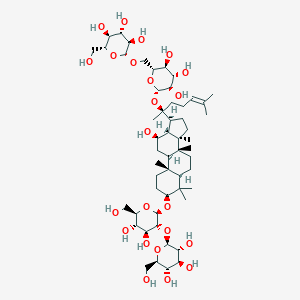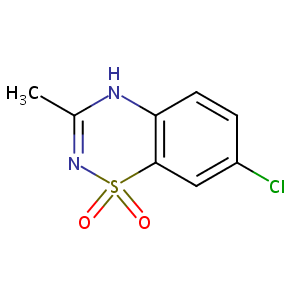| 1 |
Recurrent recessive mutation in deoxyguanosine kinase causes idiopathic noncirrhotic portal hypertension.Hepatology. 2016 Jun;63(6):1977-86. doi: 10.1002/hep.28499. Epub 2016 Mar 31.
|
| 2 |
Diazoxide FDA Label
|
| 3 |
URL: http://www.guidetopharmacology.org Nucleic Acids Res. 2015 Oct 12. pii: gkv1037. The IUPHAR/BPS Guide to PHARMACOLOGY in 2016: towards curated quantitative interactions between 1300 protein targets and 6000 ligands. (Ligand id: 2409).
|
| 4 |
Constitutive beta-glucosidases hydrolyzing ginsenoside Rb1 and Rb2 from human intestinal bacteria. Biol Pharm Bull. 2000 Dec;23(12):1481-5.
|
| 5 |
Intestinal bacterial hydrolysis is required for the appearance of compound K in rat plasma after oral administration of ginsenoside Rb1 from Panax ginseng. J Pharm Pharmacol. 1998 Oct;50(10):1155-60.
|
| 6 |
Characterization of the ginsenoside-transforming recombinant beta-glucosidase from Actinosynnema mirum and bioconversion of major ginsenosides into minor ginsenosides. Appl Microbiol Biotechnol. 2013 Jan;97(2):649-59.
|
| 7 |
Fermentation of protopanaxadiol type ginsenosides (PD) with probiotic Bifidobacterium lactis and Lactobacillus rhamnosus. Appl Microbiol Biotechnol. 2017 Jul;101(13):5427-5437.
|
| 8 |
Developing a metagenomic view of xenobiotic metabolism. Pharmacol Res. 2013 Mar;69(1):21-31.
|
| 9 |
Genus Enhydrobacter Staley et al. 1987 should be recognized as a member of the family Rhodospirillaceae within the class Alphaproteobacteria. Microbiol Immunol. 2012 Jan;56(1):21-6.
|
| 10 |
Metabolism of ginsenoside Re by human intestinal microflora and its estrogenic effect. Biol Pharm Bull. 2005 Oct;28(10):1903-8. doi: 10.1248/bpb.28.1903.
|
| 11 |
Ginsenoside Rb1 protects against 6-hydroxydopamine-induced oxidative stress by increasing heme oxygenase-1 expression through an estrogen receptor-related PI3K/Akt/Nrf2-dependent pathway in human dopaminergic cells. Toxicol Appl Pharmacol. 2010 Jan 1;242(1):18-28. doi: 10.1016/j.taap.2009.09.009. Epub 2009 Sep 23.
|
| 12 |
Ginsenosides may enhance the functionality of human embryonic stem cell-derived cardiomyocytes in vitro. Reprod Sci. 2014 Oct;21(10):1312-8. doi: 10.1177/1933719114525269. Epub 2014 Mar 10.
|
| 13 |
Modulating effect of ginseng saponins on heterologously expressed HERG currents in Xenopus oocytes. Acta Pharmacol Sin. 2005 May;26(5):551-8. doi: 10.1111/j.1745-7254.2005.00116.x.
|
| 14 |
Ginsenoside Rb1 alleviates liver injury induced by 3-chloro-1,2-propanediol by stimulating autophagic flux. J Food Sci. 2021 Dec;86(12):5503-5515. doi: 10.1111/1750-3841.15968. Epub 2021 Nov 23.
|
| 15 |
Pharmacodynamics of ginsenosides: antioxidant activities, activation of Nrf2, and potential synergistic effects of combinations. Chem Res Toxicol. 2012 Aug 20;25(8):1574-80. doi: 10.1021/tx2005025. Epub 2012 Aug 9.
|
| 16 |
Drugs@FDA. U.S. Food and Drug Administration. U.S. Department of Health & Human Services.
|
| 17 |
Antihypertensive drugs clonidine, diazoxide, hydralazine and furosemide regulate the production of cytokines by placentas and peripheral blood mononuclear cells in normal pregnancy. J Hypertens. 2006 May;24(5):915-22. doi: 10.1097/01.hjh.0000222762.84605.03.
|
| 18 |
Diazoxide-mediated preconditioning against apoptosis involves activation of cAMP-response element-binding protein (CREB) and NFkappaB. J Biol Chem. 2004 Nov 5;279(45):46748-54. doi: 10.1074/jbc.M406217200. Epub 2004 Aug 23.
|
| 19 |
Diazoxide-mediated growth inhibition in human lung cancer cells via downregulation of beta-catenin-mediated cyclin D1 transcription. Lung. 2009 Jan-Feb;187(1):61-7. doi: 10.1007/s00408-008-9127-1. Epub 2008 Dec 4.
|
| 20 |
Combined contributions of over-secreted glucagon-like peptide 1 and suppressed insulin secretion to hyperglycemia induced by gatifloxacin in rats. Toxicol Appl Pharmacol. 2013 Feb 1;266(3):375-84. doi: 10.1016/j.taap.2012.11.015. Epub 2012 Nov 28.
|
|
|
|
|
|
|


